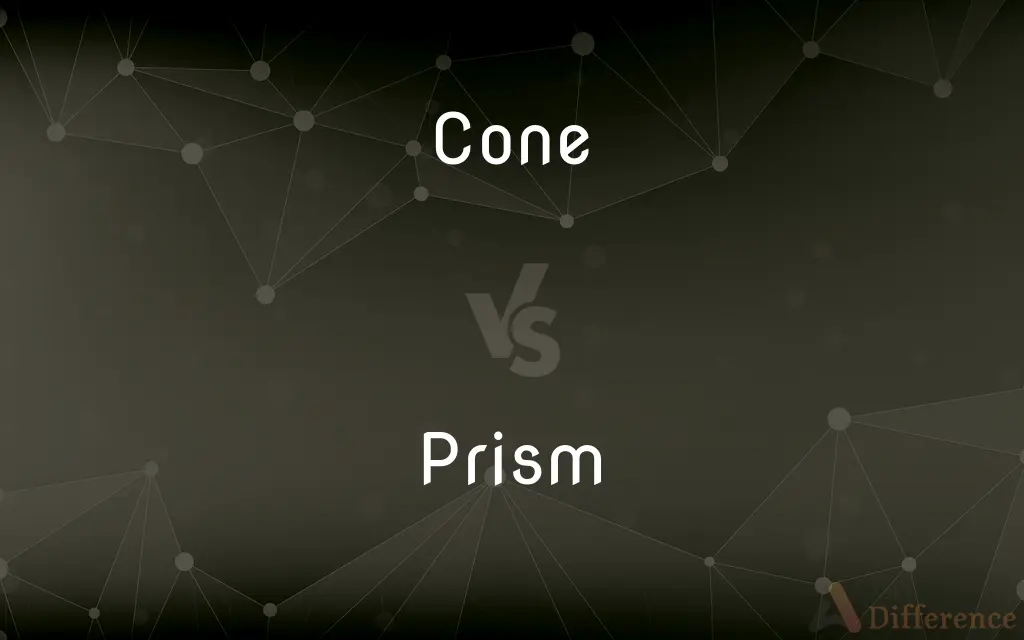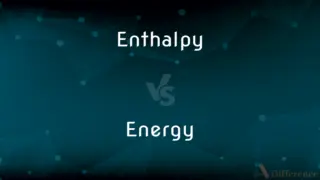Cone vs. Prism — What's the Difference?
By Tayyaba Rehman & Maham Liaqat — Updated on March 22, 2024
A cone is a three-dimensional geometric shape with a circular base tapering smoothly to a point, while a prism is a polyhedron with two parallel, congruent bases connected by rectangular faces.

Difference Between Cone and Prism
Table of Contents
ADVERTISEMENT
Key Differences
A cone is defined by its singular circular base and a vertex that is not on the base, creating a shape that tapers smoothly from the base to the point. This characteristic makes cones unique in their appearance and properties, such as having only one edge (the circle itself) and no vertices in the traditional sense (except for the apex). In contrast, a prism is a type of polyhedron characterized by two parallel, congruent bases and faces that are parallelograms (most commonly rectangles). The sides of a prism are perpendicular to the bases, and its shape depends on the polygonal nature of these bases, such as triangular prisms, rectangular prisms, or hexagonal prisms.
Cones are often seen in real life in objects that require a gradual transition from a base to a point, such as ice cream cones and traffic cones. These applications take advantage of the cone's ability to direct movement or substances efficiently. Prisms, on the other hand, are utilized in situations requiring uniform cross-sections along a length, such as in prism-shaped buildings or the prisms used in optical instruments to refract light.
The geometric properties of cones and prisms, such as symmetry and shape, are dictated by their definitions. Cones have a circular symmetry around the central axis and a single point of convergence at the apex. Prisms exhibit translational symmetry along their length and rotational symmetry around their central axis, depending on the shape of the bases.
Comparison Chart
Base Shape
Circular
Polygonal (triangular, square, etc.)
Faces
1 curved surface + 1 base
2 congruent bases + rectangular sides
ADVERTISEMENT
Real-life Examples
Ice cream cones, traffic cones
Buildings, optical prisms
Geometric Properties
Circular symmetry, 1 edge, no vertices (except apex)
Translational and rotational symmetry, based on the base shape
Compare with Definitions
Cone
Volume of a cone is calculated as one-third the product of the base area and height.
Calculating the volume of a traffic cone can help in designing its weight for stability.
Prism
Prisms are used in optical devices to refract or reflect light.
Prism binoculars provide clear, magnified images.
Cone
The surface area of a cone includes its base and its lateral surface area.
Painting a cone-shaped roof requires calculating its surface area for adequate coverage.
Prism
The volume of a prism is the area of the base times the height.
Water tanks are often prismatic to simplify volume calculations.
Cone
A cone is a solid with a circular base tapering to a point.
A funnel is shaped like a cone to direct liquid.
Prism
A prism is a polyhedron with two parallel, congruent polygonal bases.
A glass prism can split white light into a spectrum of colors.
Cone
Cones have a circular base and a single vertex not on the base.
The lampshade was cone-shaped to diffuse light effectively.
Prism
Optical device having a triangular shape and made of glass or quartz; used to deviate a beam or invert an image
Cone
Cones are used in applications requiring a smooth flow from a wide to a narrow end.
Ice cream cones are designed to hold a scoop securely at the top.
Prism
Prisms have bases that are polygons and faces that are parallelograms.
The toy block was a rectangular prism, easy for stacking.
Cone
A cone is a three-dimensional geometric shape that tapers smoothly from a flat base (frequently, though not necessarily, circular) to a point called the apex or vertex. A cone is formed by a set of line segments, half-lines, or lines connecting a common point, the apex, to all of the points on a base that is in a plane that does not contain the apex.
Prism
An optical prism is a transparent optical element with flat, polished surfaces that refract light. At least one surface must be angled — elements with two parallel surfaces are not prisms.
Cone
A solid or hollow object which tapers from a circular or roughly circular base to a point
A cone of acrylic yarn
Stalls selling paper cones full of fresh berries
Prism
A solid figure whose bases or ends have the same size and shape and are parallel to one another, and each of whose sides is a parallelogram.
Cone
The dry fruit of a conifer, typically tapering to a rounded end and formed of a tight array of overlapping scales on a central axis which separate to release the seeds
A cedar cone
Prism
A transparent body of this form, often of glass and usually with triangular ends, used for separating white light passed through it into a spectrum or for reflecting beams of light.
Cone
One of two types of light-sensitive cell in the retina of the eye, responding mainly to bright light and responsible for sharpness of vision and colour perception.
Prism
A cut-glass object, such as a pendant of a chandelier.
Cone
Separate off or mark a road with traffic cones
Part of the road has been coned off
Prism
A crystal form consisting of three or more similar faces parallel to a single axis.
Cone
The surface generated by a straight line, the generator, passing through a fixed point, the vertex, and moving along a fixed curve, the directrix.
Prism
A medium that misrepresents whatever is seen through it.
Cone
A right circular cone.
Prism
(geometry) A polyhedron with parallel ends of the same size and shape, the other faces being parallelogram-shaped sides.
Cone
The figure formed by a cone, bound or regarded as bound by its vertex and a plane section taken anywhere above or below the vertex.
Prism
A transparent block in the shape of a prism (typically with triangular ends), used to split or reflect light.
Cone
Something having the shape of this figure
"the cone of illuminated drops spilling beneath a street lamp" (Anne Tyler).
Prism
A crystal in which the faces are parallel to the vertical axis.
Cone
A similar, spore-producing structure of club mosses, horsetails, and spikemosses.
Prism
A solid whose bases or ends are any similar, equal, and parallel plane figures, and whose sides are parallelograms.
Cone
A reproductive structure resembling a cone, such as the female inflorescence of a hop plant or the woody female catkin of an alder.
Prism
A transparent body, with usually three rectangular plane faces or sides, and two equal and parallel triangular ends or bases; - used in experiments on refraction, dispersion, etc.
Cone
(Physiology) One of the photoreceptors in the retina of the eye that is responsible for daylight and color vision. These photoreceptors are most densely concentrated in the fovea centralis, creating the area of greatest visual acuity. Also called cone cell.
Prism
A polyhedron with two congruent and parallel faces (the bases) and whose lateral faces are parallelograms
Cone
Any of various gastropod mollusks of the family Conidae of tropical and subtropical seas that have a conical, often vividly marked shell and that inject their prey with poisonous toxins, which can be fatal to humans. Also called cone shell.
Cone
To shape (something) like a cone or a segment of one.
Cone
(geometry) A surface of revolution formed by rotating a segment of a line around another line that intersects the first line. Category:en:Surfaces
Cone
(geometry) A solid of revolution formed by rotating a triangle around one of its altitudes.
Cone
(topology) A space formed by taking the direct product of a given space with a closed interval and identifying all of one end to a point.
Cone
Anything shaped like a cone.
Cone
The fruit of a conifer.
Cone
A cone-shaped flower head of various plants, such as banksias and proteas.
Cone
An ice cream cone.
Cone
A traffic cone
Cone
A unit of volume, applied solely to marijuana and only while it is in a smokable state; roughly 1.5 cubic centimetres, depending on use.
Cone
(anatomy) Any of the small cone-shaped structures in the retina.
Cone
(slang) The bowl piece on a bong.
Cone
(slang) The process of smoking cannabis in a bong.
Cone
(slang) A cone-shaped cannabis joint.
Cone
(slang) A passenger on a cruise ship (so-called by employees after traffic cones, from the need to navigate around them)
Cone
(category theory) An object V together with an arrow going from V to each object of a diagram such that for any arrow A in the diagram, the pair of arrows from V which subtend A also commute with it. (Then V can be said to be the cone’s vertex and the diagram which the cone subtends can be said to be its base.)
A cone is an object (the apex) and a natural transformation from a constant functor (whose image is the apex of the cone and its identity morphism) to a diagram functor. Its components are projections from the apex to the objects of the diagram and it has a “naturality triangle” for each morphism in the diagram. (A “naturality triangle” is just a naturality square which is degenerate at its apex side.)
Cone
A shell of the genus Conus, having a conical form.
Cone
A set of formal languages with certain desirable closure properties, in particular those of the regular languages, the context-free languages and the recursively enumerable languages.
Cone
(transitive) To fashion into the shape of a cone.
Cone
(intransitive) To form a cone shape.
Cone
(frequently followed by "off") To segregate or delineate an area using traffic cones.
Cone
A solid of the form described by the revolution of a right-angled triangle about one of the sides adjacent to the right angle; - called also a right cone. More generally, any solid having a vertical point and bounded by a surface which is described by a straight line always passing through that vertical point; a solid having a circle for its base and tapering to a point or vertex.
Cone
Anything shaped more or less like a mathematical cone; as, a volcanic cone, a collection of scoriæ around the crater of a volcano, usually heaped up in a conical form.
Now had Night measured with her shadowy coneHalf way up hill this vast sublunar vault.
Cone
The fruit or strobile of the Coniferæ, as of the pine, fir, cedar, and cypress. It is composed of woody scales, each one of which has one or two seeds at its base.
Cone
A shell of the genus Conus, having a conical form.
Cone
To render cone-shaped; to bevfl like whe circwlar segoent of a cone; as, to cone the tires of car wheels.
Cone
Any cone-shaped artifact
Cone
A shape whose base is a circle and whose sides taper up to a point
Cone
Cone-shaped mass of ovule- or spore-bearing scales or bracts
Cone
Visual receptor cell sensitive to color
Cone
Make cone-shaped;
Cone a tire
Common Curiosities
What are practical applications of cones and prisms?
Cones are used in traffic cones and ice cream cones for their directing ability; prisms are used in buildings and optical instruments for their uniform cross-sections and light-refracting properties.
What makes a shape a cone or a prism?
A shape is a cone if it has a circular base and tapers to a point; it's a prism if it has two parallel, congruent polygonal bases connected by rectangular sides.
Can a prism have a circular base?
No, a prism cannot have a circular base, as its bases must be polygonal. Shapes with circular bases, like cylinders, are not classified as prisms.
Can cones and prisms have the same base area?
Yes, a cone and a prism can have the same base area, but their volumes and surface areas will differ due to their shapes.
How does the shape of a prism's base affect its properties?
The polygonal shape of a prism's base determines its volume and surface area calculations, as well as its symmetry and structural applications.
Why is the volume formula for a cone one-third that of a cylinder?
The volume formula for a cone is one-third that of a cylinder with the same base and height because geometrically, a cone can be thought of as having one-third the volume of a cylinder, a concept proven through calculus and the principle of Cavalieri.
What types of prisms are there based on their base shapes?
Prisms are categorized by their base shapes, such as triangular prisms, rectangular prisms, and hexagonal prisms, each with unique properties and formulas for volume and surface area.
Why are cones not considered prisms?
Cones have a single curved surface and taper to a point, unlike prisms, which have flat, parallelogram faces and two congruent polygonal bases, making their geometric properties distinct.
Can the concept of a cone be applied in non-physical, abstract ways?
Yes, the concept of a cone can be applied abstractly in fields like graph theory and data visualization, where hierarchical structures or data sets might be represented as cone-like to illustrate relationships or data flow from a broad base to a specific point.
How does light refraction work in prisms?
Light refraction in prisms occurs because different colors of light travel at different speeds when passing through the prism material, causing them to bend at varying angles and separate into a spectrum.
How do environmental conditions affect the stability of cones and prisms in architecture?
Environmental conditions such as wind, earthquakes, and gravity affect the stability of cones and prisms differently due to their shapes. Prisms, with their uniform cross-section, might distribute stress more evenly, while cones, tapering to a point, could offer less resistance to certain forces, influencing design considerations in architecture.
Share Your Discovery

Previous Comparison
Sunni vs. Wahabi
Next Comparison
Enthalpy vs. EnergyAuthor Spotlight
Written by
Tayyaba RehmanTayyaba Rehman is a distinguished writer, currently serving as a primary contributor to askdifference.com. As a researcher in semantics and etymology, Tayyaba's passion for the complexity of languages and their distinctions has found a perfect home on the platform. Tayyaba delves into the intricacies of language, distinguishing between commonly confused words and phrases, thereby providing clarity for readers worldwide.
Co-written by
Maham Liaqat













































